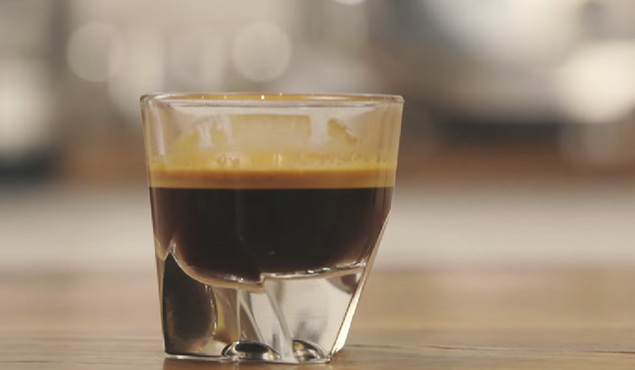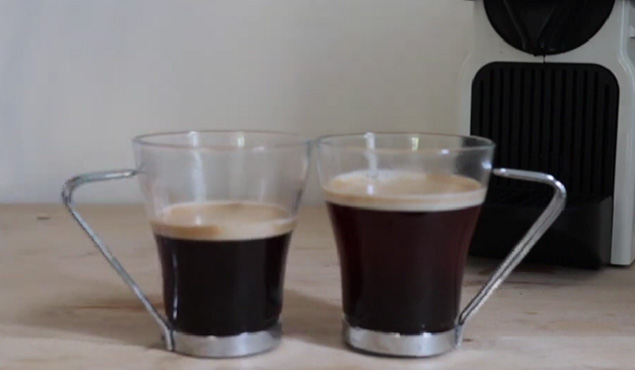Lungo vs. Espresso: What’s the Difference?

In your search for the best coffee, have you come across any new coffee-based beverages at local coffee shops? If yes, you may have heard about two popular coffee drinks: lungo and espresso.
While both Lungo and Espresso use finely ground coffee beans and hot water, they differ in their brewing methods. Due to different brewing techniques, lungo and espresso have unique tastes.
Lungo means “long” in Italian. A Lungo consists of one shot of espresso pumped through twice as much hot water.
On the other hand, espresso machines push hot water through finely-ground coffee beans, thus producing a concentrated and bold espresso shot.
So, which one suits your coffee preferences better? Join us as we explore the world of coffee and dive into the differences between a Lungo and an Espresso.
From taste and quantity to caffeine content and texture, we’ll examine the key differences between these coffee drinks to help you find your perfect brew.
Let’s begin!
Lungo vs. Espresso: At a Glance
| Consideration | Lungo | Espresso |
| Brew time | 1-2 minutes | 20-30 seconds |
| Caffeine content | 90-135 mg | 80-120 mg |
| Flavor profile | Bitter, less intense coffee taste. | More concentrated, strong coffee flavor. |
| Serving size | 3-4 oz/cup | 1-2 oz/cup |

What is a Lungo?
Lungo is an Italian term that means “long.” In coffee terms, it refers to a type of coffee made by pulling a long espresso shot and adding hot water.
It results in a larger volume of coffee and a milder taste than other espresso-based drinks.
In Italy, most coffee lovers like to have lungo first thing in the morning to get their caffeine kick. It is the perfect drink for people who prefer a less intense coffee but a more bitter flavor.
You can easily prepare a Lungo at home using single-serve coffee makers, such as Nespresso machines. Thanks to Nespresso, Lungo coffee has risen in popularity worldwide.
There is a Lungo option on most Nespresso machines. You can also brew a larger Lungo coffee with Nespresso’s Gran Lungo capsule for its Vertuo machines.
Nespresso coffee pods make it easy and convenient to enjoy the mild taste of Lungo coffee on the go. Additionally, you can use a lungo as a base to create other coffee drinks, including lattes and cappuccinos.
What is the Origin of Lungo?
Originating from Italy, lungo is now a famous worldwide beverage. The word “lungo” comes from the Italian phrase “caffè lungo,” which means “long coffee.”
In the early 20th century, lungo became a great alternative to espresso shots. For people who didn’t like espresso’s bitter and bold taste, lungo came as a blessing.
Lungo became one of the favorite coffee drinks for people who preferred milder and less intense coffee taste.

How to Prepare a Lungo at Home?
Here is the straightforward method of brewing the perfect Lungo:
What you will need:
- An Espresso Machine (I’m using Nespresso)
- Coffee Beans/Lungo Pods
- Water
Method:
- Grind fresh coffee beans and tamp them into your espresso machine’s portafilter.
- If you are using a Nespresso. Insert a lungo pod into the pod holder. I’m using a Volluto coffee pod.
- Start brewing the espresso as you usually would, but let the machine run for a longer time, around 1.5-2 minutes.
- Once the espresso machine pulls a shot, add hot water to the espresso to increase its volume.
Related Read: Is Nespresso Worth It? Pros Cons And Things To Consider Before Buying
Pros and Cons
Like any coffee drink, lungo has pros and cons. Here are some of them:
Pros:
- It has a milder taste than other espresso-based drinks, making it a perfect choice for those who prefer a less intense coffee flavor.
- Lungo gives the perfect caffeine kick since it takes longer to pull, extracting more caffeine.
- It is an excellent base for creating coffee drinks like lattes and cappuccinos.
Cons:
- The extended brewing time can make the coffee taste bitter.
- It might not have the same crema as a regular espresso shot.
- Adding too much water can dilute the coffee’s flavor.
Variations
Vivalto Lungo is a decaffeinated version of Lungo coffee made with specific coffee beans. Unfortunately, Nespresso discontinued Vivalto Lungo in 2021.
Fortissio Lungo is a variation of Lungo coffee with a dark and malty flavor. It makes a more intense coffee compared to a regular lungo shot.
Another variation of Lungo coffee is Linizio Lungo, made with Robusta coffee beans instead of Arabica. This Lungo option has slightly more caffeine than regular Lungo coffee.
What is an Espresso?
An espresso shot is a concentrated form of full-bodied and flavorful coffee. Many people love espresso due to its strong and intense flavor that gives them an instant energy boost.
Espresso’s brewing method makes it different from other coffee types. During brewing, the espresso machine forces hot water through finely-ground coffee for a short period, usually between 20 and 30 seconds.
Due to the high pressure used during the brewing process, coffee beans retain high flavor concentration levels. As a result, an espresso shot contains a layer of crema and a robust flavor profile.
Espresso is also a base for many hot beverages and iced drinks, including lattes, cappuccinos, and americanos.
If you have an espresso machine at home, you can enjoy it on its own or try out different coffee recipes and be your own barista.

Origin of Espresso
Europe quickly became a famous coffee-drinking nation after the invention of espresso in Italy in the early 20th century.
Although the first espresso coffees were bitter and burned in taste, the following decades brought about all sorts of experiments to perfect the brew.
Espresso soon became a staple in the united states. People enjoy an espresso as it is but also love espresso-based drinks like lattes and cappuccinos.
Related Read: What are Espresso Drinks? 23 Best To Try Out!
How to Make Espresso at Home?
Making a perfect espresso at home is challenging but straightforward with an espresso machine. Here’s how:
What you will need
- An Espresso machine
- Espresso pod
- Water
Method
- Fill the reservoir of your espresso machine.
- Turn on the espresso machine and wait till it heats up.
- Open the machine head and Insert a coffee pod into the pod holder.
- Close the machine head properly.
- Place a mug on the drip tray.
- Press the espresso button.
- Your brewer will start dispensing coffee!
Pros and Cons
Espresso has its own set of pros and cons. Let’s look at them:
Pros:
- It has a rich, bold flavor unique to coffee drinks.
- As a result of instant brewing, it has a creamy, thick consistency.
- This versatile beverage can be a base for many other coffee drinks, including lattes, macchiatos, americanos, and cappuccinos.
Cons:
- Compared with a lungo, it contains less caffeine.
- Coffee drinkers who prefer a milder flavor may not have an espresso.
- Brewing the perfect espresso shot can be challenging without an espresso machine.
Variations
You can use an Espresso as a base for the majority of popular coffee drinks, and there are various variations that you can try out. Some include the following:
- Macchiato
Preparing a macchiato includes adding a small amount of foamed milk to a shot of espresso. It is a strong coffee drink with a slightly sweet taste.
- Cappuccino
A cappuccino adds equal parts of espresso, steamed, and foamed milk. It is a creamy coffee drink that is popular all over the world.
Related Read: Macchiato vs. Cappuccino (Key Differences And Recipe)
- Latte
Making a latte involves adding steamed milk to a shot of espresso. This milder coffee drink is perfect for those who prefer a less intense coffee flavor.
- Ristretto
Ristretto is a more concentrated espresso variation with less water and more coffee grounds.
- Americano
Contrary to a ristretto, an Americano uses more water on top, with an espresso base.
Related Read: How To Make Iced Americano? [Easy Steps To Follow]
Lungo vs. Espresso: The Key Differences
Now you know all about Lungo and Espresso, let’s look at the key differences between them:
Taste
When it comes to coffee drinks, the taste is a determining factor in choosing which suits your taste preferences.
Both espresso and lungo feature the bitter flavor of traditional double espresso shots, but their tastes differ.
Espresso has a rich, rich, slightly bitter taste from concentrated coffee. The brewing process involves pulling a shot quickly and with a small amount of water, resulting in a somewhat sweet but more intense flavor often compared to dark chocolate.
In contrast, the coffee machine pulls a lungo shot more slowly with more water, making it more bitter coffee but less intense than an espresso shot.
The extended brewing time of lungo coffee also exposes some fruity notes from the coffee beans, producing a slightly less intense taste than espresso but with a more complex flavor profile.

Brewing process
The espresso brewing process involves forcing hot water through finely-ground coffee beans using high pressure, which results in a concentrated shot of coffee.
The brewing time for an espresso shot is typically between 20-30 seconds.
On the other hand, the lungo brewing process involves pulling a long shot of espresso pod, resulting in a less concentrated coffee and less intense coffee than espresso.
The lungo brewing process takes longer, typically around 60-120 seconds, and involves adding more hot water to the espresso shot.
The longer brewing time for lungo allows for a slower extraction process. It exposes some of the fruity and aromatic notes in the coffee beans, resulting in a more complex and bitter taste than espresso, which has a more robust and concentrated flavor.
Quantity
There is a significant difference between a lungo and espresso regarding their quantity (serving size).
For instance, the serving size or quantity of lungo is much larger than a regular espresso shot since it uses additional water for brewing. This results in a coffee beverage with a milder taste but a much larger volume.
Hence, Lungo is typically served in a 3-4 ounce cup, while espresso is a smaller 1-2 ounce cup.
The smaller size of an espresso shot helps preserve the coffee’s intense and concentrated flavor.
Caffeine Content
The caffeine content of espresso and lungo depends on the type and amount of coffee beans used and the duration of the extraction process.
A lungo has approximately 90-135 mg of caffeine per cup, while an espresso has 80-120 mg of caffeine per cup.
A lungo shot has more caffeine because the brewing process takes more time to force hot water through the coffee beans. In comparison, espresso has a shorter extraction time and contains less caffeine.
Despite a lungo shot having more caffeine, it has double the water volume, making it a less concentrated coffee. It means a lungo doesn’t taste as strong as a regular espresso shot.
Appearance
Espresso has a thick, velvety layer of crema on top, created during brewing.
The natural oils and sugars from the coffee beans form the crema. The crema on the espresso is a sign of a well-brewed shot.
The crema is often dark brown and has a slightly bubbly texture. The crema is integral to the espresso-drinking experience as it contributes to the drink’s aroma, flavor, and mouthfeel.
In contrast, lungo typically has a thinner layer of crema than espresso because it uses more water, diluting the foam on top.
The appearance of the lungo may also be lighter in color than espresso due to the added water.
Texture
Lungo coffee has a lighter texture than espresso because of the added water. The water also reduces the crema, which is the creamy layer on top of the coffee drink.
On the other hand, espresso has a thick, creamy texture resulting from the shorter brewing process.
The high pressure used to brew espresso creates a dense, velvety crema on top of the shot.
The Bottom Line
In conclusion, when it comes to lungo vs. espresso, both coffees have unique flavors and use different brewing techniques.
Lungo coffee is a milder coffee drink that is perfect for those who prefer a less intense coffee flavor, while espresso is a bold, rich coffee drink unique to espresso.
The critical differences between Lungo and espresso are their taste, quantity, caffeine content, flavor, and texture.
Regardless of your choice, both Lungo and espresso are excellent coffee drinks that will satisfy your taste buds.
FAQs
Is lungo the same as ristretto?
No, lungo and ristretto are not the same. Ristretto is a concentrated espresso shot made with the same coffee as a regular espresso shot but with less water. On the other hand, Lungo uses more water and has a milder taste than ristretto.
Do I use espresso or Lungo for the latte?
Lungo is typically used for making lattes, as it has a milder flavor and larger volume than espresso. However, choosing between espresso or lungo ultimately depends on personal preference.
Is Nespresso lungo an Americano?
No, Nespresso lungo is not an Americano. An Americano coffee drink includes adding hot water to a shot of espresso. On the other hand, to prepare a Nespresso Lungo, the brewer pulls a more extended shot of espresso.
Can you use a Nespresso pod twice?
No, Nespresso doesn’t recommend using its pods twice. Nespresso pods are for single use only, and using them more than once can result in a less intense and bland cup of coffee.
Is Lungo more bitter than espresso?
Lungo is typically more bitter than espresso, as the longer brewing time and additional water can extract more bitter flavors from the coffee beans. However, the bitterness level ultimately depends on personal taste preferences.
Do you put chilled or hot water in Nespresso?
The Nespresso machine heats water to the optimal temperature for brewing coffee, so adding cold water may produce a less flavorful coffee.
